
Did you know that 50% of all costs you will spend on an application go as direct labor costs to the coders? If you need to decrease your expenditures on a bright tech idea realization, you should start with outsourcing software development. Let’s break down all the delivery models with pros and cons so you can choose an outsourcing type that suits your business best.
Content:
- Why would you need IT outsourcing?
- A step-by-step guide: How to outsource software development
- Kinds of IT services you can outsource
- The geography of outsourcing – the best countries for IT outsourcing
- Possible pitfalls of IT outsourcing and ways to deal with them
- Summing up
Why would you need IT outsourcing?
According to one of the latest Deloitte surveys, 33 to 57% of respondents choose traditional outsourcing and other delivery models due to the need to cut costs. The market responds by creating new outsourcing types and relocating its shared service centers to more cost-efficient locations. As direct labor cost minimization is an obvious benefit of outsourced software product development, let’s list all the other perks your business will gain with IT outsourcing.
Risk mitigation
A year has passed since the massive IT company layoffs in November 2022, but tech companies still remember how devastating overhiring can be. With IT outsourcing, you can avoid risks associated with overhiring, namely excess labor costs and the challenge of downsizing if the business needs to change. By outsourcing, you can scale your workforce up or down without the complexities of hiring and layoffs.
Reduction in infrastructure investment
As your IT vendor will provide your remote workforce office premises, hardware, and software. You don’t have to worry or pay for these expenditures. Moreover, as your outsourcing partner takes charge of your remote dedicated team, you don’t have to spend the resources of your administrative staff (HR managers, accountants, office managers) either.
Access to unique expertise
Outsourcing provides access to a wide range of specialized skills and expertise that might not be available in-house. This is particularly beneficial for short-term projects requiring specialized knowledge. Outsourcing opens up a global talent pool, allowing businesses to benefit from diverse perspectives and innovative approaches from a broader, international workforce.
Due to the unique expertise you get your hands on, you can your business can also expect improved operational productivity, as outsourced teams have specialized skills and tools to execute tasks more efficiently.
A step-by-step guide: How to outsource software development?
Successful IT services outsourcing requires clear communication, mutual understanding, and flexibility to adapt as the project evolves. Each of the steps above should be approached with diligence to ensure a successful partnership and project outcome.
Step 1: Define your project requirements

- 1.1 Identify goals. Clearly define what you want to achieve with the software. Is it to improve efficiency, reach new markets, or provide a new service?
- 1.2 Scope of work. Outline the functionalities, features, and performance requirements of the software.
- 1.3 Budget and timeline. Establish your budget limits and the desired timeline for project completion.
Step 2: Choose the right outsourcing model
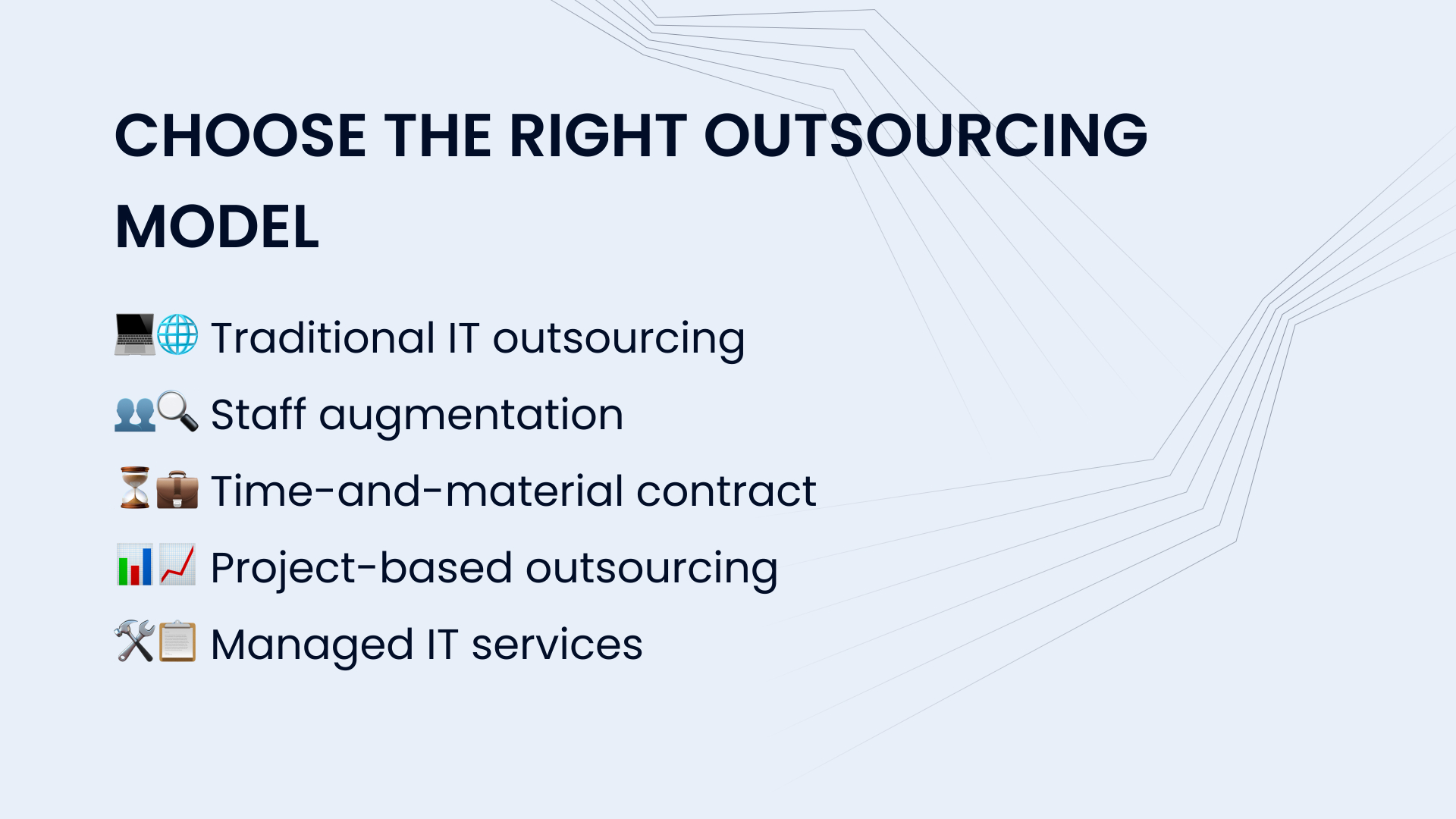
As the IT outsourcing market grows, IT vendors offer new, enhanced, and improved approaches to keep everybody secure and profitable. Here are five key methods how to outsource software development.
2.1 Traditional IT outsourcing. This involves contracting an external organization to handle specific IT functions, like software development, maintenance, or infrastructure management. Even though it is cheaper than maintaining an in-house team, IT outsourcing is considered quite expensive, as your IT vendor puts all the possible risks it can face into its fee.
The best choice for companies who need particular services from time to time and don’t want to hire an entire IT department for these needs. It can be a school outsourcing help desk functions to an onshore IT provider.
2.2 Staff augmentation. This model supplements a company’s existing IT staff with external professionals. It’s helpful in adding specific skills or extra manpower for short-term projects without hiring full-time employees.
The best choice for technological startups that already have an IT department that they don’t want to increase. Good for both those who need a dedicated team of five or more people and for those who are looking for a particular expert.
2.3 Time-and-material contract. Under this model, services are billed based on the time spent and materials used. It’s flexible and often used for projects where the scope isn’t strictly defined.
The best choice for a tech startup working on an innovative product. With this model, the startup can adjust the workload and project direction without being locked into a fixed scope, allowing it to innovate and iterate rapidly while effectively managing costs.
2.4 Project-based outsourcing. Here, an entire project is outsourced to a service provider, who is responsible for delivering the project within a defined timeline and budget.
The best choice for non-technical companies who want to come up with their own app. For example, a brick-and-mortar shop that wants to develop its e-commerce branch and offer its clients an application should go to a software development outsourcing company focused on project-based cooperation.
2.5 Managed IT services. In this approach, an external provider manages and assumes responsibility for a set/an infrastructure of IT services, offering ongoing support and management. Managed services can handle everything from network management and cybersecurity to routine maintenance, thus reducing the company’s operational risks and enhancing efficiency without the need for a large in-house IT department.
The best choice for a mid-sized manufacturing company with limited IT expertise. By outsourcing their IT management, they can ensure their IT infrastructure is professionally managed, secure, and up-to-date, allowing them to focus on their core manufacturing processes.
Step 3: Vendor selection
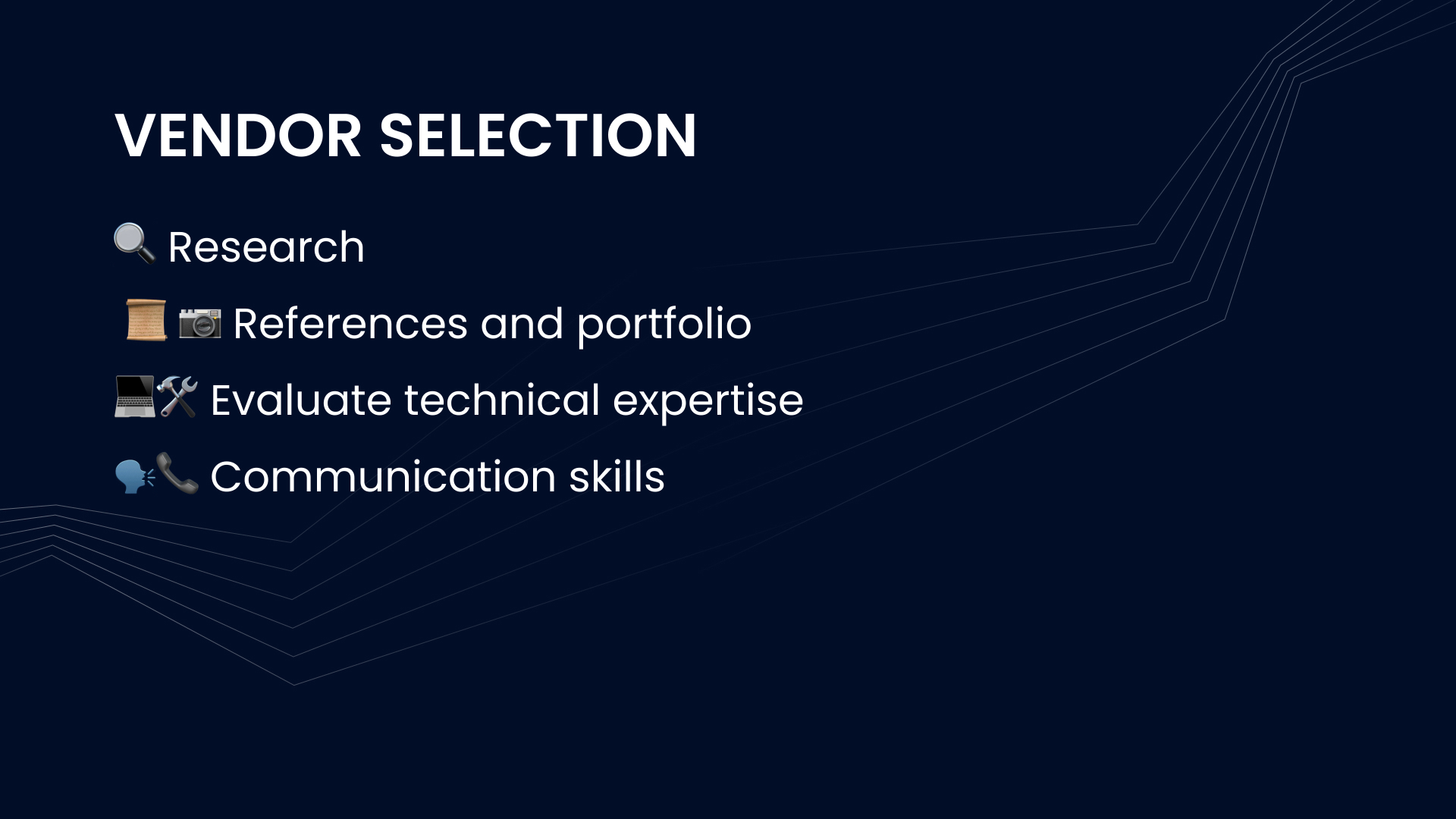
- 3.1 Research. Look for vendors with expertise in the technology stack required for your project.
- 3.2 References and portfolio. Check their past work and ask for client references.
- 3.3 Evaluate technical expertise. Consider conducting a technical interview or a test project.
- 3.4 Communication skills. Ensure they have good communication skills and effective project management tools.
Step 4: Legal and security considerations
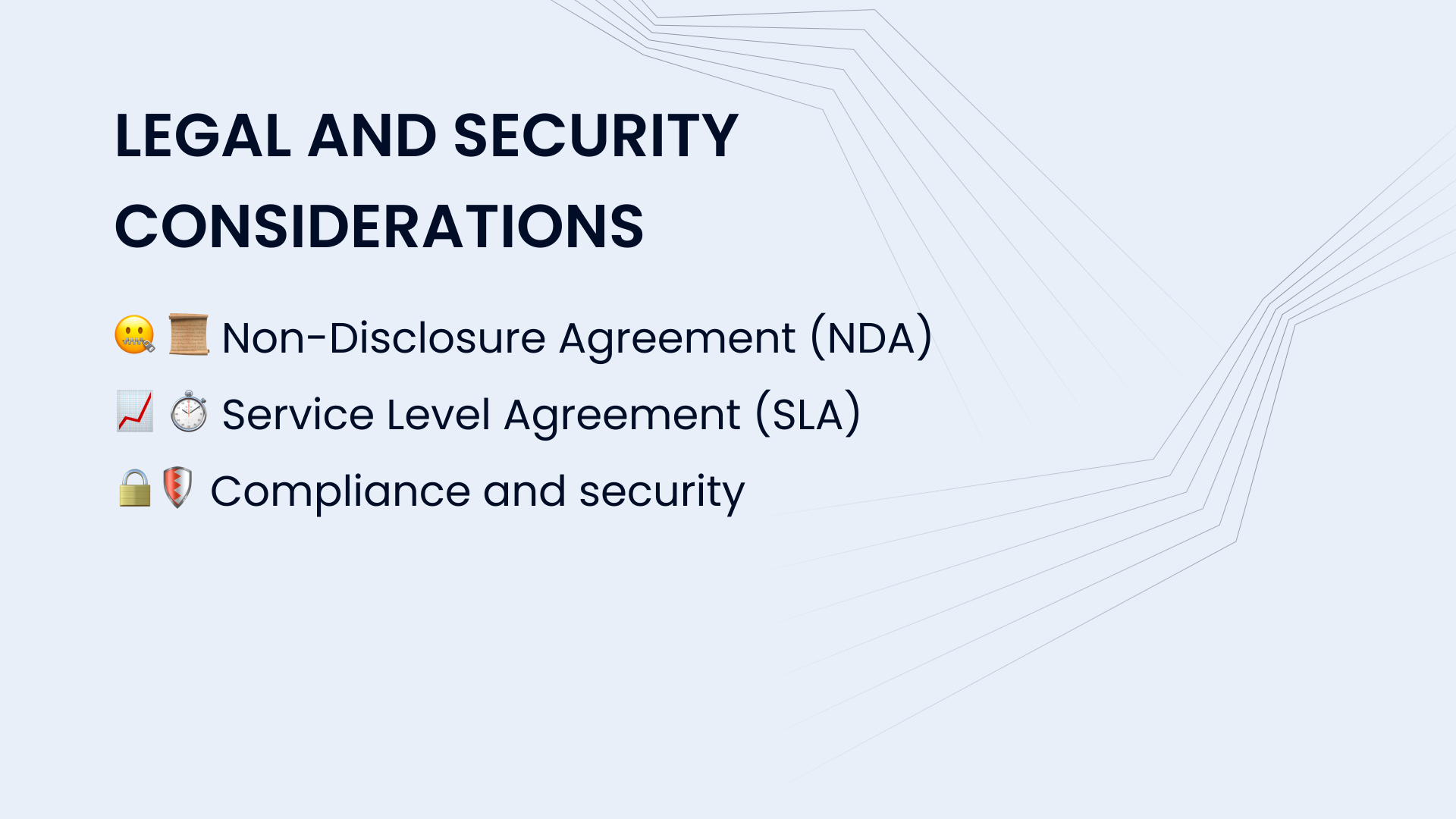
- 4.1 Non-Disclosure Agreement (NDA). Protect your intellectual property and confidential information.
- 4.2 Service Level Agreement (SLA). Define the level of service expected, including quality, responsibilities, and timelines.
- 4.3 Compliance and security. Ensure the vendor adheres to necessary data protection laws and security protocols.
Step 5: Project management and communication
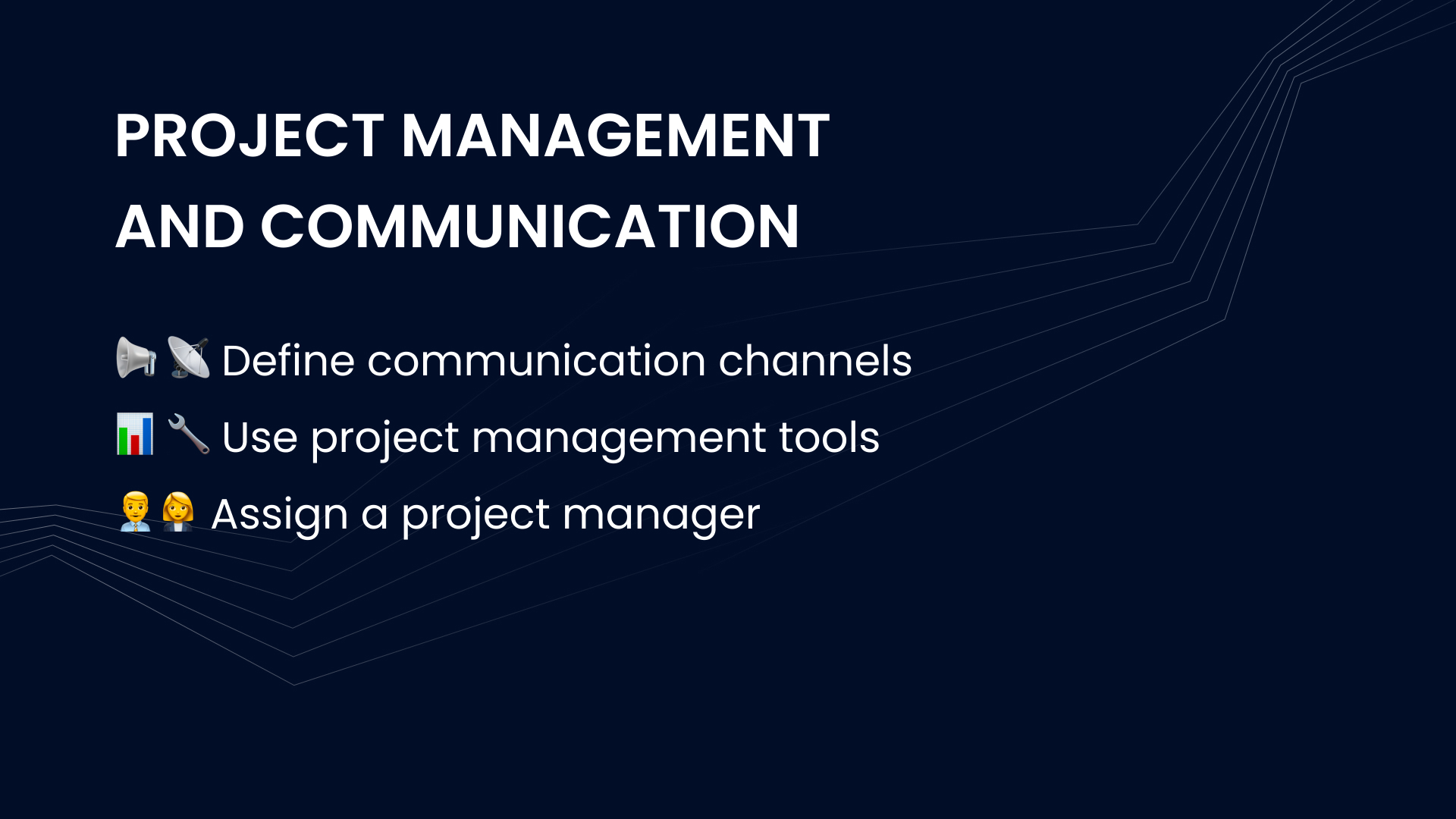
- 5.1 Define communication channels. Establish how and when you will communicate (e.g., weekly calls, email updates).
- 5.2 Use project management tools. Tools like JIRA, Trello, or Asana can help track progress.
- 5.3 Assign a project manager. Either from your team or the vendor’s team to be the primary point of contact.
Step 6: Kick-Off and development

- 6.1 Initiation meeting. Align on goals, expectations, and processes.
- 6.2 Agile methodology. Consider adopting an agile approach for flexibility and regular feedback.
- 6.3 Regular check-ins. Schedule regular status meetings to discuss progress, challenges, and feedback.
Step 7: Quality assurance

- 7.1 Testing. Ensure thorough testing is conducted throughout the development process.
- 7.2 Feedback loop. Implement a system for providing and incorporating feedback.
Step 8: Deployment and support

- 8.1 Deployment. Plan and execute the deployment of the software.
- 8.2 Post-deployment support. Ensure you have an agreement for ongoing maintenance and support.
Step 9: Review and feedback

- 9.1 Project review. After completion, review the project’s success against initial goals and objectives.
- 9.2 Vendor feedback. Provide feedback to the vendor and discuss any future collaboration.
Step 10: Future scalability

Plan your project’s scalability. Discuss with the vendor how future modifications and expansions will be handled.
Kinds of IT services you can outsource
IT vendors are not only about outsourcing software development services. According to Deloitte surveys and industry insights, these are the most common tech services that are delegated to third parties.
- App development and maintenance. This includes custom software development, updates, and maintenance of existing applications.
- Web development and hosting. Designing, developing, and hosting websites, including backend services.
- Cybersecurity services. Protecting data and networks from cyber threats, implementing security protocols.
- Cloud services. Managing cloud-based services and infrastructure, including migrations to cloud platforms.
- Database management. Administration and maintenance of database systems.
- IT support and helpdesk services. Providing technical support and helpdesk services for internal or external users.
- Network management. Handling network infrastructure, including monitoring and maintenance.
- Data analytics and business intelligence. Analyzing data to provide insights for business decisions.
- ERP systems management. Implementing and managing Enterprise Resource Planning systems.
- Quality assurance and testing. Ensuring the quality and functionality of software through various testing methods.
These services cover a broad spectrum of IT needs, allowing businesses to access specialized skills and technologies without the overhead of maintaining a large in-house IT team.
The geography of outsourcing – the best countries for IT outsourcing
The best answer to “How much does it cost to outsource software development?” will be “It depends.” It mostly depends on the country where your IT vendor is situated.

But first, here are some theoretical facts. Outsourcing based on geography can be categorized into three primary types: onshore, nearshore, and offshore outsourcing.
- Onshore outsourcing involves outsourcing services to a provider located in the same country as the client’s business.
- In nearshore outsourcing, businesses outsource to service providers in neighboring or nearby countries, often sharing similar time zones and cultural affinities.
- Offshore outsourcing refers to outsourcing services to a provider in a distant country, often with significant cost advantages but also with potential challenges like cultural differences and time zone disparities.
So, if you’re a California-based US company, go to Texas for onshore outsourcing, choose Canada or Mexico for nearshore outsourcing, and opt for Ukraine or Vietnam for offshore outsourcing.
But where exactly should you go for the best price-to-quality ratio? Here is a comparative perspective of the IT landscape in the top ten outsourcing destinations.
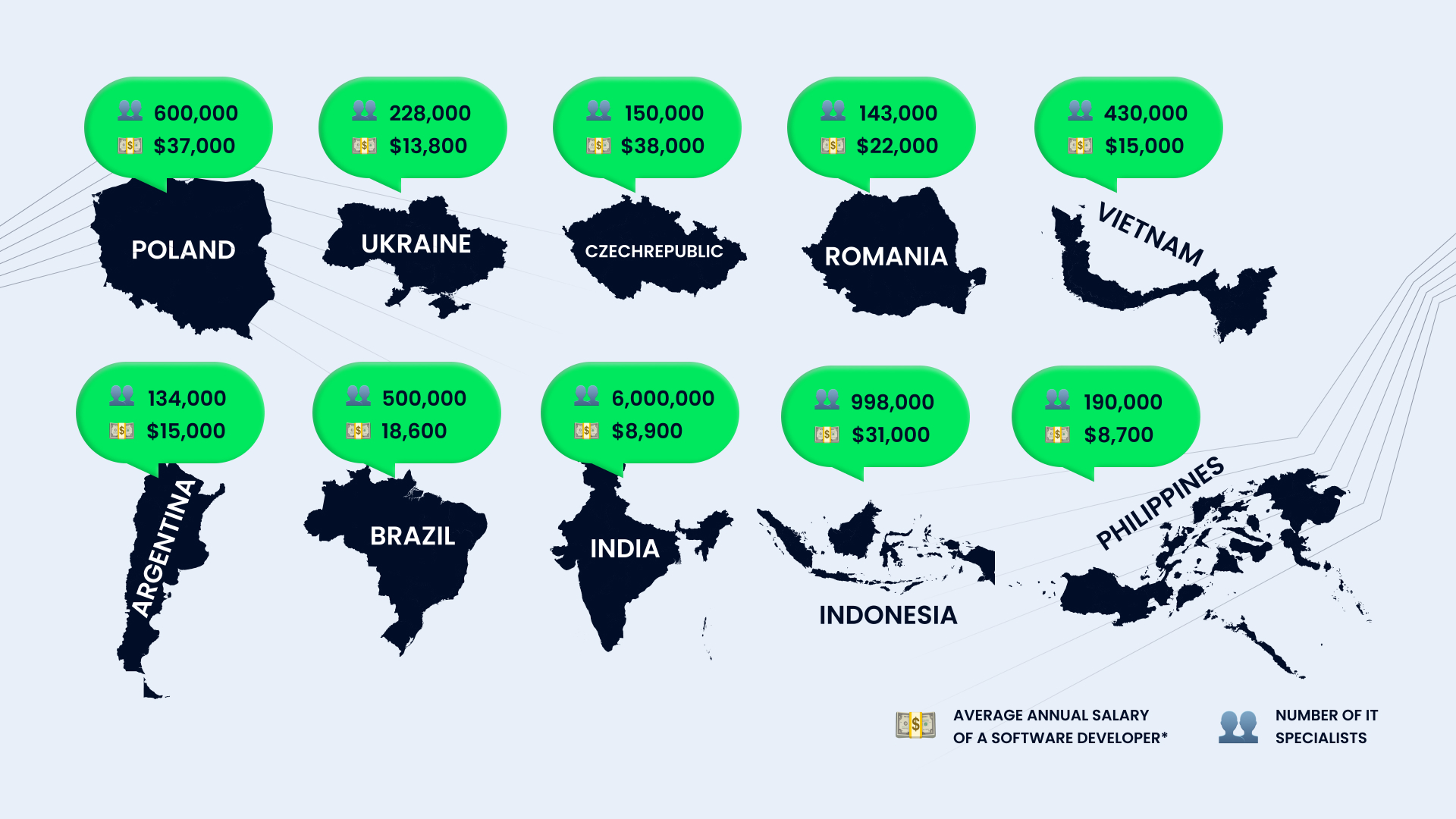
| Country | Number of IT specialists | Average annual salary of a software developer* |
|---|---|---|
| Ukraine | 228,000 | $13,800 |
| India | 6,000,000 | $8,900 |
| Vietnam | 430,000 | $15,000 |
| Poland | 600,000 | $37,000 |
| Philippines | 190,000 | $8,700 |
| Brazil | 500,000 | 18,600 |
| Romania | 143,000 | $22,000 |
| Czech Republic | 150,000 | $38,000 |
| Argentina | 134,000 | $15,000 |
| Indonesia | 998,000 | $31,000 |
*Salaries can vary significantly based on experience, skills, and other factors.
Possible pitfalls of IT outsourcing and ways to deal with them
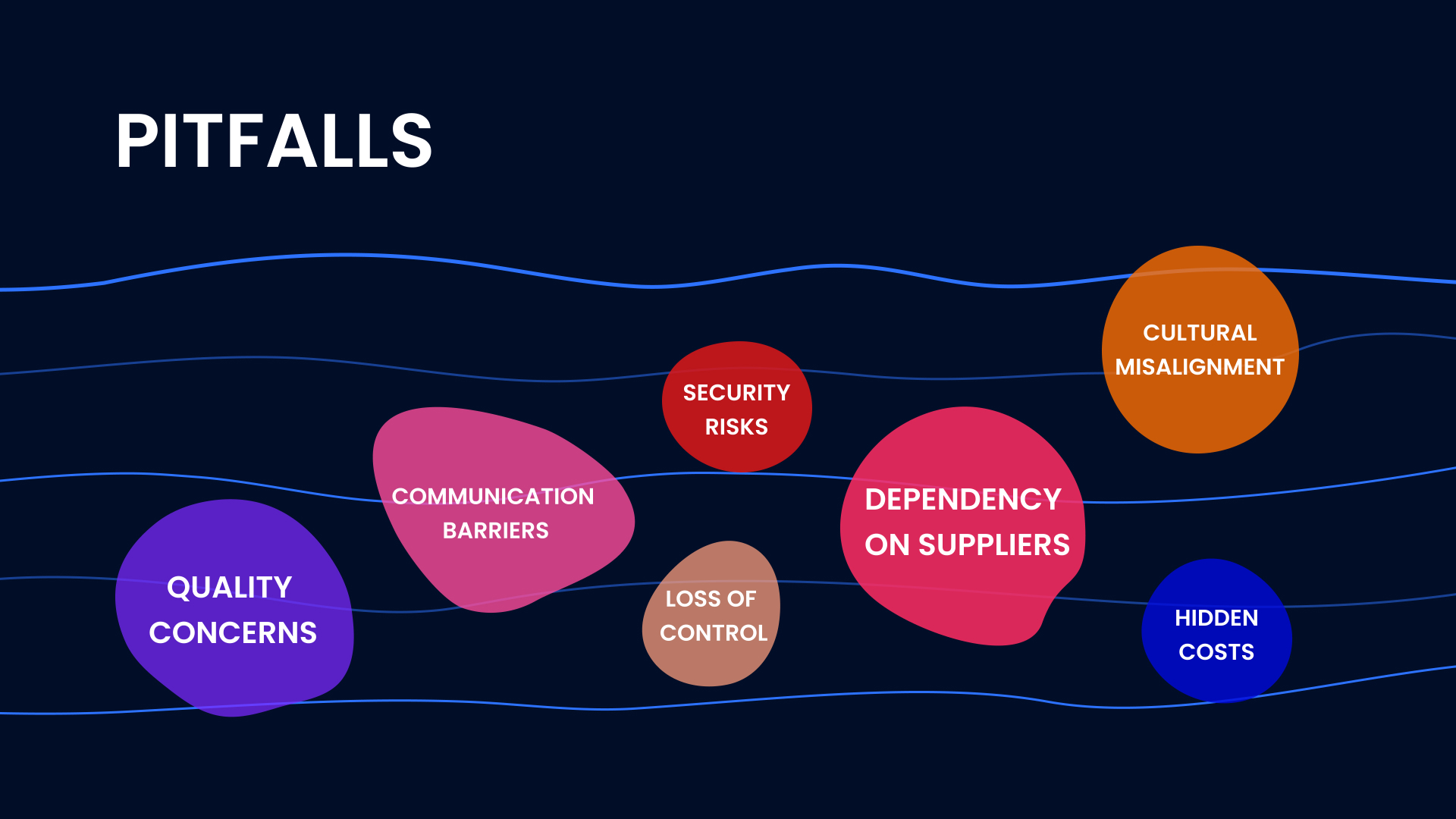
The point of this article is how to SUCCESSFULLY outsource software development and that’s because delegation of IT services can come with its share of challenges and potential pitfalls. Here are some of the most common issues and ways to address them.
Quality concerns
Pitfall. The quality of work might not meet expectations or be consistent with internal standards.
Solution. Establish clear quality benchmarks and standards. Regular quality checks and maintaining open communication lines can help ensure that the work meets the required standards.
Communication barriers
Pitfall. Differences in language, culture, or time zones can lead to misunderstandings or delays.
Solution. Use collaborative tools and technologies to facilitate communication. Schedule regular meetings and align on a common language for business communications.
Loss of control
Pitfall. Outsourcing can sometimes lead to a feeling of reduced control over certain processes or outputs.
Solution. Clearly define the scope, goals, and expectations of the project. Maintain oversight through regular updates and reports.
Security risks
Pitfall. Sharing sensitive data or granting system access can pose security threats.
Solution. Conduct thorough due diligence on the outsourcing partner. Implement strong data protection policies and ensure the partner adheres to them.
Dependency on suppliers
Pitfall. Over-reliance on external vendors can become a risk if the vendor faces problems or the relationship ends.
Solution. Develop a contingency plan and maintain an in-house team or multiple suppliers to reduce dependency.
Hidden costs
Pitfall. Unexpected costs may arise, negating some of the cost-saving benefits of outsourcing.
Solution. Have a detailed contract outlining all potential costs. Monitor and manage the project budget closely.
Cultural misalignment
Pitfall. Differences in work culture can lead to misaligned expectations and work ethics.
Solution. Choose a vendor with a similar work culture or one adaptable to your practices. Foster mutual understanding through cultural exchange initiatives.
But the key challenge is your first one – choosing your IT vendor.
Summing up
Now you understand why outsource software development and know how to do that, avoiding pitfalls. Every choice you make (of a vendor or a type of cooperation) will depend on the needs of your project. If the information we provide is not enough to make a well-informed decision about IT services delegation, contact our managers. Due to 20 years of IT consulting and staffing, we can answer most questions you might have. Let’s schedule a call and discuss your fabulous project!
Content
- 1 Why would you need IT outsourcing?
- 2 A step-by-step guide: How to outsource software development?
- 2.1 Step 1: Define your project requirements
- 2.2 Step 2: Choose the right outsourcing model
- 2.3 Step 3: Vendor selection
- 2.4 Step 4: Legal and security considerations
- 2.5 Step 5: Project management and communication
- 2.6 Step 6: Kick-Off and development
- 2.7 Step 7: Quality assurance
- 2.8 Step 8: Deployment and support
- 2.9 Step 9: Review and feedback
- 2.10 Step 10: Future scalability
- 3 Kinds of IT services you can outsource
- 4 The geography of outsourcing – the best countries for IT outsourcing
- 5 Possible pitfalls of IT outsourcing and ways to deal with them
- 6 Summing up
